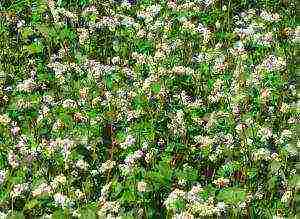As is the case with most other edible mushrooms, the common name - camelina - does not refer to one species, but to several similar ones at once. All of them are edible, and some are deservedly considered among the best mushrooms. Mushroom pickers love and respect the mushroom very much for its prevalence and the complete absence of poisonous counterparts.
The content of the article:
- Types of saffron milk caps
- Ryzhiki - photo and description
- Fried, boiled, pickled and pickled mushrooms
- Is it possible to grow mushrooms at home?
Types of saffron milk caps
The name camelina is applied to six distinct species that have similar external characteristics. So, under this term the following types of lamellar fungi of the biological genus Mlechnik are known:
- Ginger is real. When they say "mushroom", in most cases they mean this particular mushroom. It has a high nutritional value and is excellent for pickling and pickling, not to mention the standard heat treatment. In addition, a powerful antibiotic is obtained from this mushroom, which helps in the fight against serious diseases such as tuberculosis.
- Spruce ginger. Although in Western literature this species is considered unfit for food due to bitterness, in Russia, spruce mushrooms are considered good edible mushrooms.
- Red ginger. Quite rare, but also quite edible mushroom. Like real camelina, it is used in the pharmaceutical industry.
- Pine mushroom. Nice edible mushroom, although quite rare. Despite the fact that some biologists consider it just a kind of spruce camelina, mushroom pickers at all times distinguished these two mushrooms.
- Japanese ginger. On the territory of Russia, it is found exclusively in the southern part of Primorye. It is quite suitable for human consumption.
- Salmon or alpine mushroom. Found in the north of the European part of our country. Nutritional characteristics are closest to that of pine mushroom.

It is noteworthy that there is no such thing as a false mushroom historically. On the territory of Russia there are no poisonous mushrooms that would look like edible varieties of camelina.
However, today on the Internet the term "false saffron milk" is still used. We owe its appearance to the fact that the general level of knowledge of the population about forest mushrooms has dropped to a catastrophically low level. "False mushrooms" are any mushrooms that are even remotely similar, but inedible. Also, sometimes this term is called pink volushka - a conditionally edible mushroom that has a lot of external differences from camelina and grows not in coniferous forests, but in birch groves.
Ryzhiki - photo and description
So, you have decided to go on a quiet hunt for mushrooms, but you do not know what they look like and where to look for them. Let's take a look at this issue and see a photo and description of saffron milk caps.

These mushrooms got their name for the characteristic color of the fruit body. Despite some external differences, all mushrooms carry one or another shade of red, ranging from light yellow-pink mushrooms to rich orange-red. Another characteristic feature of saffron milk caps is the presence of red or orange milky juice oozing from the cut.
Almost the same shape of the cap is characteristic of all mushrooms of this group. In young mushrooms, it is convex, and with age it becomes funnel-shaped. In this case, the edges of the cap are first rolled up, then straightened. Also, in all saffron milk caps, the leg has a shape close to a regular cylinder.
Now let's look at what specific species of mushrooms look like:
- Ginger is real. The average diameter of the cap is 7-12 cm. The color is light orange with many spots of a darker shade. The length of the leg does not exceed 5-7 cm. The color is the same as that of the cap, but sometimes it is lighter. The yellow-orange pulp sometimes turns green at the cut.Sap in the air often turns green pigmentation. The fungus can be found in coniferous forests in grass or on moss. It grows most actively in the period from late July to early September.

- Spruce ginger. The diameter of the cap is no more than 6-8 cm. The skin is orange, covered with spots of darker shades, with age it becomes covered with green spots. The leg grows to 6-7 cm in length. Painted in the same shade as the hat. The pulp is orange at the edges, and white or light yellow in the middle. The break point quickly turns red, but then turns green. Also, the description of spruce camelina includes an abundant release of dark orange juice at the cut. The fungus grows near spruce trees, preferring coniferous litter. The harvesting season is summer and autumn.
- Red ginger. The size of the fruiting body is the same as that of a real saffron milk cap. There are many color options for the cap, but usually it has one of the shades between dirty orange and yellow-red. The pulp is white with irregular red patches. A thick juice of a rich orange or even red color comes from the cut site. The stem often tapers towards the base, the whole is dotted with pits of a darker color. Sometimes the mushroom can have a rather unusual color of the leg and the lower part of the cap - lilac or purple. You can meet this mushroom only in coniferous mountain forests in summer and autumn.
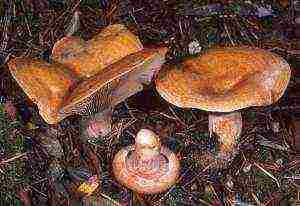
- Pine mushroom. As evidenced by the photo and description of these mushrooms, pine mushrooms are very similar to their spruce counterpart, but with some important differences. And the most important of them is the place of growth - a pine forest, not a spruce forest. The color of the cap is more intense and closer to red than yellow. Concentric rings are more pronounced. The pulp is denser, and the surface of the mushroom is never covered with green spots. However, the place of the cut, as expected, turns green in the air. Pine camelina appears in the forest at the end of summer.
- Japanese ginger. The size of the fruit body is the same as that of a pine mushroom. Concave caps show concentric growth zones. The color ranges between pale terracotta and ocher salmon. The plates under the cap are usually much brighter and are colored a mixture of red, pink and orange. The pulp at the cut site rarely turns green, just being covered with juice. The fungus grows under fir trees in the valley forests of Primorsky Krai. Ripening time - September-October.
- Salmon or alpine mushroom. The largest mushroom among all the mushrooms. The size of the cap can reach 20 cm, although the leg is short - no more than 5 cm. The mushroom mushroom, according to the description of mushroom pickers, is always quite bright - saturated carrot color with distinct concentric growth zones. As the mushroom ages, the edges of the cap turn pale. The pulp is bright carrot at the edges, white in the center. The place of the cut does not change in color, but carrot-colored juice is abundantly released from it. It also grows exclusively under fir trees from August to October. Distributed in the north of the European part of Russia.

Fried, boiled, pickled and pickled mushrooms
Ryzhiks are edible even with minimal processing. They can be served even by simply scalding them with boiling water. Of course, they can also be boiled, fried, salted and pickled. Camelina prepared by any of these methods are perfect for boiled vegetables, including potatoes, they are added to salads, and they make filling for pies and dumplings. Camelina soup is generally a unique dish in its deliciousness. Finally, these mushrooms make a good mushroom sauce for meat.
There is no need to boil mushrooms before cooking. It is enough just to scald with boiling water for disinfection. However, the mushrooms need to be rinsed and peeled before use.
If you want to prepare mushrooms for the winter, then they can be salted or pickled. But drying these mushrooms is somehow not accepted, although it is quite possible.
For salting, the mushrooms are cleaned and put in a large saucepan or bucket, sprinkled with salt and spices.The filled bucket is covered with a lid, pressed down with some kind of weight and placed in a dark, cool place. After about two weeks, you can already try such mushrooms. Salted mushrooms go well in salads and hot vegetable dishes. If you plan to store such mushrooms for more than a couple of months, then it is recommended to boil them for 5-10 minutes before salting.
There is also a more emergency salting method. Thoroughly peeled mushrooms are placed in a deep bowl with the legs up and "headlong" covered with salt. Already after two hours, such mushrooms can be served to the table, after rinsing, of course. However, mushrooms salted in this way cannot be stored for a long time.
An alternative way of harvesting is pickled mushrooms. Water with salt and spices is used as a marinade. After a short boil, add a little vinegar to it, and then pour this mixture into jars with mushrooms previously washed and scalded with boiling water. Pickled mushrooms are ready in about a month, but they can be stored for a long time.
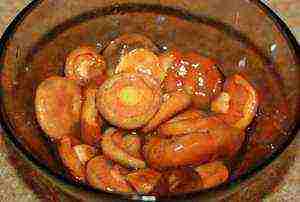
If you have only a couple of kilograms of these wonderful mushrooms at your disposal, then it would be most reasonable to use them right away. The mushrooms fried with onions in butter are especially good. Stewed cabbage, fried potatoes, and other vegetables will suit them.
Another option is mushrooms stewed with sour cream, meat, vegetables and even apples. Finally, as testimonials testify, mushrooms are great for making soup.
Is it possible to grow mushrooms at home?
The vast majority of forest mushrooms are almost impossible to cultivate. They live only in natural conditions and categorically refuse to grow in conditions of industrial cultivation - in premises or greenhouses on artificial compost soil. And mushrooms are no exception.
Of course, you can ensure that these mushrooms grow in your summer cottage in the garden, but just keep in mind that the harvest will be quite meager and hardly enough to pamper your family with fresh mushrooms. There is no commercial cultivation for profit here: too much hassle with little result. If you want to make money on mushrooms, then it is better to pay attention to more productive species - champignons, oyster mushrooms, shiitake, etc.
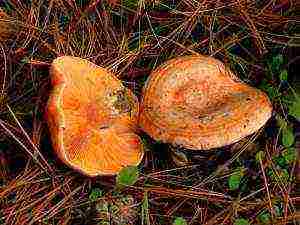
To grow mushrooms at home, you need to create conditions for them that would most accurately reproduce the coniferous forest. Ideally, they should be planted under a spruce or pine tree. Moreover, to increase the likelihood of a successful outcome of this enterprise, it is recommended to deliver a couple of cubic meters of real forest soil and forest floor from the forest.
Also try to recreate the level of light and humidity that is typical for a coniferous forest as accurately as possible. You can rest assured that saffron milk caps will refuse to grow on the hot soil of the sun or in acidic swampy soil. Ryzhiks prefer shaded areas with good air circulation. Moreover, they need moderately moist soil containing a large amount of decaying needles and foliage. Areas that are flooded with water during spring floods or summer showers are categorically unsuitable.
The classic and easiest way to plant forest mushrooms is to use mushroom spores. To do this, you need old saffron milk caps, or rather their caps, which should be cut as small as possible, and then dried, gently scattered over damp ground and sprinkled with damp soil on top. The sowing site should be tamped moderately and watered a little with water at room temperature.
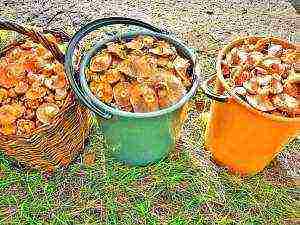
An alternative way is to pour the same caps of old mushrooms with warm water with sugar dissolved in it. After a day, the mushrooms need to be kneaded with hands into a gruel and poured together with water at the planting site. For greater reliability, then the planted material is also recommended to be covered with a thin layer of soil.
The third option is more troublesome, but gives a slightly better chance of success.It consists in planting a ready-made mycelium. Theoretically, you can order a mycelium in one of the online stores, but there is always a question of what exactly will be sent to you - whether that type of mushroom, and a living mycelium or its mummy. Therefore, it is best to go to the forest on your own and dig out the mycelium there.
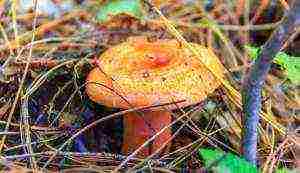
You need to dig a whole layer of earth with dimensions of at least 20x20 cm around the fruiting body of the fungus. It is very important not to shake the earth on the way home, so as not to kill the mycelium. It is necessary to plant a layer with mycelium immediately, without waiting for the earth to dry out.
The landing site should coincide as much as possible with the place from which the mycelium was dug. The type of soil, humidity, lighting level and the proximity of trees of the same species are important. For this reason, it is better to look for mushrooms in the forest for mushrooms growing on an area that is as close as possible to your garden, and only there to dig mycelium.
The landing site must be watered regularly, preventing the topsoil from drying out. The first harvest should be expected only the next year after planting.
Mainly mushrooms grow in the forests of the Urals, the Far East and Siberia. From a distance you can see its funnel-shaped cap, smooth and slightly slimy to the touch. The mushroom cap itself can have a fairly diverse color palette, from bright orange to green. Dark circles must be present on the hat.
The mushroom leg is empty and smooth. It usually matches the color of the mushroom, but sometimes it can be a little lighter. If you cut the flesh of the mushroom, then it will begin to exude a pleasant resinous aroma, and the color of the flesh on the cut will begin to turn green over time. The fungus is very actively attacked by insects and their larvae.
Growing saffron milk caps at home
 To start growing mushrooms at home, you need to decide on the choice and preparation of the place. These mushrooms grow only in natural conditions, and in order to grow them on your garden plot, you will need to choose a place so that it does not differ much from where the mushroom grows in natural conditions.
To start growing mushrooms at home, you need to decide on the choice and preparation of the place. These mushrooms grow only in natural conditions, and in order to grow them on your garden plot, you will need to choose a place so that it does not differ much from where the mushroom grows in natural conditions.
Growing saffron milk caps is not as easy as it might seem at first glance. Lighting, humidity, soil conditions and the age of the surrounding trees must be taken seriously. Ryzhiks are very fond of shaded areas with free air circulation. As for the soil, it must be moist with a high content of decaying foliage and needles. But at the same time, with the onset of spring, this area should not be flooded with water, otherwise all the mushrooms will simply disappear.
Sowing mycelium
There are several ways of sowing saffron milk caps.
The first is to collect the caps of old mushrooms, chop them finely and, after drying on a fabric surface, gently introduce these dry particles into damp ground. After that, the soil should be well tamped and irrigated with warm water.
The second method is to pour warm sweetened water over the old mushroom caps for a while. The next day, after mixing well, pour the dough under the desired trees and wait.
The third way is the possibility of transferring a ready-made mycelium. It must be carefully dug without damaging it in the form of a layer with a thickness of at least 25 cm. Carrying the layer home, do not shake it, otherwise you will damage the entire mycelium. The layer should be planted without waiting for the earth to dry out. It is advisable to do this under the same trees where the mycelium was dug. Remember to water your mycelium often with rainwater. This mushroom loves moist soil.
Harvesting the grown crop
The main concern during the cultivation of saffron milk caps is watering the land in dry weather. Water the mushroom place with rainwater. The first mushrooms will sprout only the next year after you have planted the mycelium. Mushrooms must be collected by carefully cutting the leg with a knife, being careful not to damage the root.If you do not heed this condition, then next year the number of mushrooms will not increase, but, on the contrary, will decrease, and this, you will agree, is not very pleasant.
Did you like the article?
Share the link
Receive new articles by mail
If your garden plot is adjacent to a forest or individual trees (birch, aspen, spruce or pine) grow on it, then you can try growing porcini mushrooms, aspen mushrooms or boletus boletus and mushrooms there, although success cannot be guaranteed.
The fact is that most of the valuable forest mushrooms are in a complex symbiosis with trees. Their mycelium grows together with the roots of trees, forming a fungus root, or mycorrhiza. These mushrooms are called mycorrhizal. Their connection with trees is very complex and strong. The mycorrhizal fungi, although bad, can still grow without a tree, but the mushrooms themselves cannot form without it. So far, it has not been possible to breed mycorrhizal fungi in artificial conditions.
However, it is possible to grow them in natural conditions, and amateur mushroom growers have already accumulated quite a lot of experience in this matter. Especially appreciated porcini mushrooms and camelina have been grown in Russia since the end of the last century. Now amateurs breed mostly white.
Previously, this method was practiced. Overripe porcini mushrooms were poured into a wooden bowl with rainwater, kept for about a day, then stirred, filtered through a rare cloth and watered selected areas under the trees with this water with numerous fungal spores.
Another option. Small (from a matchbox) pieces of mycelium are transferred to the chosen place, carefully dug out where the mushrooms grew. They are carefully placed in shallow dimples, covered with a litter and slightly moistened.
If the weather is damp, then you need to moisten it only when planting, if it is dry, you need to periodically spray the litter lightly (do not water it!) So that the soil under it is always moist.
The third way is to use pieces of ripe mushroom caps. There may be different options here. Can be laid out on. loosened litter under the trees, pieces of caps of fresh ripe mushrooms. After three to four days, these pieces are removed and the litter is moistened. Dried pieces of hats are also planted, which are already placed under the litter.
In this way, I managed to breed mushrooms on my site - under several planted spruces.
Another way is to separate the tubular part of the cap from mature porcini mushrooms, grind into pieces up to 2 cm³, dry, stirring, for one and a half to two hours. Then, with a wooden spatula, lift the upper part of the litter and put two or three pieces of mushroom there, after which the litter is compacted and carefully watered.
With all these methods, the next year, you can get a small harvest of mushrooms under favorable conditions. These will be individual mushrooms or small families for now. And a year later, you can count on a more significant harvest. It should be noted that such methods of growing mycorrhizal fungi are still theoretically unsubstantiated, they are associated with weather and other factors, therefore there may be failures, but they should not confuse amateur mushroom growers.
You can try to grow forest mycorrhizal fungi in the described ways in a nearby forest or grove, where there are young (from five to 10 years old) pines, spruces, oaks. A place is chosen similar to where the planting material was taken from (in terms of soil composition, forest stand, nature of undergrowth, grass cover). Thus, it is possible to significantly increase the productivity of forest lands, especially in suburban forests, the mushroom reserves of which are gradually decreasing.
Cultivation of saffron milk caps
Ryzhiks can be pine and spruce.
Pine mushroom ... The mushroom is orange-red in color. Ryzhiks amicably parade with whole families in a young sparse pine forest, forest edges, forest glades, can form "witch's rings". It grows from June to the end of September. His cap is rounded-convex; with age, a depression forms in its middle.It has an orange-red, faded hue with concentric dark orange zones. The edges of the cap of young mushrooms are bent, straighten over time. The diameter reaches 17 cm. The pulp is dense, fleshy, orange in color, turning green at the break. The taste of the mushroom is bland. The abundant milky juice has an orange-yellow color, which turns green in the air. Spore powder - yellow; the leg is cylindrical, hollow inside, the same color as the cap, green when touched. The diameter of the leg is 2-6 cm, the height is up to 2 cm. The flesh is white inside. The mushroom has a pleasant resinous smell. In terms of taste and nutritional qualities, camelina belongs to the first category of mushrooms. This is one of the most delicious mushrooms.
Spruce ginger, or elovik. Grows in young spruce forests. The timing of fruiting is the same as that of pine mushroom. The cap is thinner, reddish red or bluish green. Milky juice is carrot-reddish in color. The leg is the same color as the cap or slightly lighter.
The most famous are Kargopol, Tver, Ivanovo, Transbaikalian mushrooms.
To grow saffron milk caps, they take old hats, lay them out on a plot under the trees and cover them with moss: pine mushrooms - under the pines, spruce - under the trees. The "beds" should be watered in case of dry weather. For control, after two weeks, raise the moss in one place. If you see greenish-purple filaments that look like mold, and the caps have disappeared, then the spores have taken root and you can expect the appearance of fungi. But sometimes the controversy doesn't germinate. This does not mean that they died. Even after a few years, when the conditions are right, they can begin to develop.
In approximately the same way, you can propagate boletus, boletus, boletus.
Under favorable conditions, mushrooms appear in small numbers the next year, and after another year there will be more of them. They begin to grow at the same time as forest mushrooms. In order for the fertility of the site to be regular, new layers with forest mushrooms are planted.
Next chapter>

